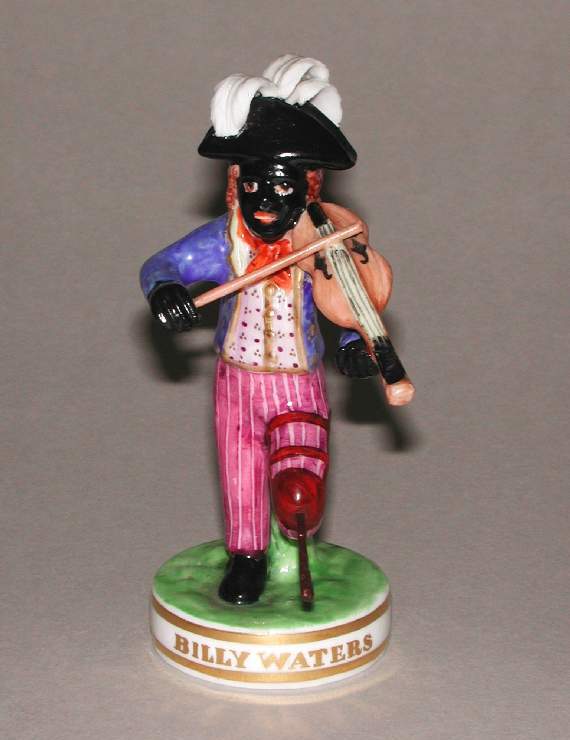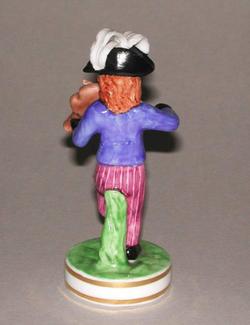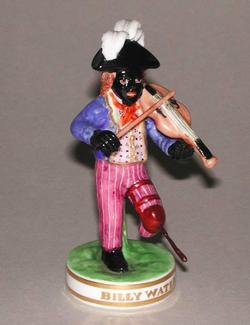Current Location: In storage
Titles
Billy Waters playing the Violin
Maker(s)
Factory:
Derby Porcelain Factory
Modeller:
Keys, Edward
(Probably)
Entities
Categories
Description
Bone china figure of a one-legged man playing the violin, painted in enamels, standing on a circular base inscribed BILLY WATERS in gold
Bone china, figure slip-cast, and painted overglaze in bright blue, green, pale yellow, dark puce, a little purple, red, pale brown, reddish-brown, and black enamels, and gilt. The underside has an unglazed border, and a lower, glazed area in the centre. The figure stands on a circular straight-side base, with a tree stump near the back. Billy Waters, a black man, stands on his right leg with his left upper leg and its projecting wooden peg leg held out in front. He supports a violin in his right hand and holds a bow to it with his right hand. He wears a black cocked hat with a white feather, a blue jacket with yellow reveres and gold buttons, a purple spotted white waistcoat with gold buttons, a red neckerchief, dark puce and white striped trousers, and black shoes. His peg-leg and its straps are reddish brown. The bow and violin are pale brown, and details of the latter are in black. The base is green on top, and, on the sides, is inscribed BILLY WATERS between two horizontal gold bands.
Notes
History note: Uncertain before donor, Mrs W.D. (Frances Louisa) Dickson
Legal notes
Given by Mrs W.D. Dickson
Measurements and weight
Height: 9.5 cm
Width: 3.8 cm
Acquisition and important dates
Method of acquisition: Given
(1932-10)
by
Dickson, W. D. (Frances Louisa), Mrs
Dating
19th Century, second half
Victoria
Circa
1862
CE
-
1898
CE
Note
Billy Waters (c. 1778-1823) was a black performer and busker who sang and played his violin for theatregoers, most often outside the Adelphi Theatre on the Strand, London, where he was noted for his peg-leg and feathered hat. Thought to have been born in North America or the Caribbean, possibly to enslavement, Waters later entered the British Navy and lost his leg during the Napoleonic wars. In trying to support his family, he busked in order to supplement his meagre naval pension. Waters was so well-known that he appeared as a character in Pierce Egan’s, 'Life in London' (1821) and the subsequent unauthorised stage production, William Thomas Moncrieff's 'Tom and Jerry, or Life in London', which ran at the Adelphi Theatre between 1821 and 1823 and at several New York theatres from 1823. Waters appeared as himself on stage in the London production. Although incredibly popular with the public, Waters ended his life in poverty, pawning his violin shortly before his death in the St Giles workhouse. He is buried in the New Burial Ground, St Pancras Church.
The modeller of this figure was identified by John Haslam (1876) as Edward Keys, who left Derby in 1826. The model is G10 in Bradshaw's list of 'Bone China Derby Models, 1810-48'. See Documentation, 1990. Other ceramic figures of Billy Waters can be found in the collections of the National Portrait Gallery (NPG D48192) and the Victoria and Albert Museum (C.317-1916 and C.38-2002).
Waters was the subject of an 1815 portrait attributed to Sir David Wilkie, and in the long tradition of depicting buskers and street-sellers, a portrait of him was included by Thomas Lord Busby in his book, 'Costume of the Lower Orders of London' (1820) (see collection of National Portrait Gallery, NPG D20528). However, this ceramic depiction of Billy Waters was derived from George Cruikshank’s depiction of Waters in the racist, anti-abolitionist print, 'The New Union Club Being a Representation of what took place at a celebrated Dinner given by a celebrated society' (19 July 1819) and Cruickshank's illustrations in Pierce Egan’s, 'Life in London' (1821). Waters is also the subject of a later print, 'The notorious Black Billy "at home" to a London street party' (1822) (Wellcome Library, no. 1962i).
People, subjects and objects depicted
Components of the work
Decoration
composed of
enamels
gold
Materials used in production
Glaze
Bone china
Techniques used in production
Slip-casting
: Bone china, slip-cast, and painted overglaze in bright blue, green, pale yellow, dark puce, a little purple, red, pale brown, reddish-brown, and black enamels, and gilt. The underside has an unglazed border, and a lower, glazed area in the centre.
Glazing (coating)
Inscription or legends present
- Text: a crown over crossed swords flanked by S and H, with .D below
- Location: On the glazed central area of the base
- Method of creation: Painted in purple enamel
- Type: Factory mark
References and bibliographic entries
Identification numbers
Accession number: C.100-1932
Primary reference Number: 71119
Stable URI
Audit data
Created: Saturday 6 August 2011
Updated: Tuesday 30 April 2024
Last processed: Thursday 14 August 2025
Associated departments & institutions
Owner or interested party:
The Fitzwilliam Museum
Associated department:
Applied Arts






